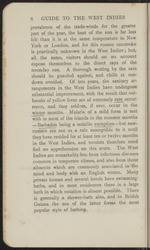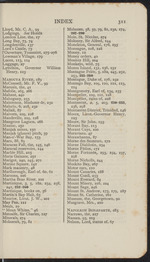| 1 |
 |
“...reason sunstroke
is practically unknown in the West Indies; but,
all the same, visitors should on no account
expose themselves to the direct rays of the
noonday sun. A thorough wetting by the rain
should be guarded against, and chills at sun-
down avoided. Of late years, the sanitary ar-
rangements in the West Indies have undergone
substantial improvement, with the result that out-
breaks of yellow fever are of extremely rare_ occur-
rence, and they seldom, if ever, occur in the
winter months. Malaria of a mild form is met
within most of the islands in the summer months
—Barbados being a notable exception—but new-
comers are not as a rule susceptible to it until
they have resided for at least ten or twelve months
in the West Indies, and tourists therefore need
feel no apprehension on this score. The West
Indies are remarkably free from infectious diseases
common in temperate climes, and also from those
ailments which are commonly associated in the
mind and body with an English winter. Many...”
|
|
| 2 |
 |
“...exports, for the last
six years:—
Year. Revenue. Expenditure. Imports. Exports.
1900 . . £39,904 £43,964 £135.507 £107,783
1901-2 . . 43.792 44.134 149,729 127,051
1902-3 . . 42,772 43.713 137.735 140,946
1903-4 • - 39.126 44.782 137.074 121,888
1904-5 • • 43.90s 42,922 141,629 141,248
1905-6. . 48,330 44.025 162,950 215,227
The principal exports in the year 1904-5 were
as follows :—
Value.
Sugar .... 12,167 tons ,£109,065
Cotton...........................2,908
St. Kitts is decidedly healthy, malaria being
almost unknown among the inhabitants. The
temperature varies from 66° to 88° Fahr. The
annual rainfall is 50 to 90 inches, and the death
rate 29 per thousand, the infant mortality?among
the negroes being, through sheer neglect alone,
very heavy.
St. Kitts was discovered by Columbus on his
second voyage in 1493, and was called by him St.
Christopher, because it is said that he saw in its
configuration a resemblance to that saint carrying
our Saviour. The Caribs used to call it Liamuiga,...”
|
|
| 3 |
 |
“...232 GUIDE TO THE WEST INDIES
The principal exports in the year 1904—5 were
as follows:—
Lime-juice and limes . . . ^7803
Sugar (429 tons) .... 3007
Cotton 1380
Climate. The climate of Montserrat is comparatively
cool and very healthy, there being no indigenous
malaria in the island, owing, probably, to the fact
that it is so well drained. Though the northern part
is rather dry as the result of deforestation, the south
has an abundance of water. The mean annual
temperature is 78° Fahr., the rainfall from 40 to 80
inches, and the death rate only 16 per thousand.
History. Montserrat was discovered by Columbus in 1493,
on his second voyage, and named by him after
a mountain near Barcelona in Spain. It was
first colonised by the English under Sir Thomas
Warner in 1632, but was captured from them by
the French in 1664. In 1668 it was restored to
England, in whose possession it remained until
1782, when it capitulated to the French. It was
again ceded to England in 1784, and since that
date it...”
|
|
| 4 |
 |
“...INDEX
Lloyd, Mr. C. A., 99
Lodgings. See Hotels
London Line, the, 17
Long Bay, 73, 74
Longdenville, 137
Lord’s Castle, 73
1’Ouverture, Toussaint, 275-276
Lowman’s Village, 179
Lucea, 113, 114
Luggage, 27
Lyttelton, Governor William
Henry, 123
Mabouya River, 189
McConnell, Mr. F. V., 99
Macusis, the, 41
Mafolie, 265, 266
Mahaut, 240
Mahogany, 253
Maintenon, Madame de, 252
Malaria, 6, 218, 232
Mallali, 87
Malvern, 109, 128
Mandeville, 109, 128
Mangrove Lagoon, 266
Manioc, 250
Manjak mines, 150
Manjak (glance) pitch, 59
Man-o’-War Bay, 153
Mara, 88, 89
Maracas Fall, the, 145, 146
Maraval reservoirs, 144
Marble Hill, 215
Marie Galante, 251
Marigot, 240, 245, 271
Marine Square, 141
Mark masonry, 48
Marlborough, Earl of, 60, 61
Maroons, 106
Martha Brae River, 101
Martinique, 3, 5, 182, 234, 238,
241, 252-260
Martinique, books on, 56
Martin’s Bay Halt, 65
Maurice, Lieut. J. W., 201
May Pen, 111
Meals, 10
" Mean Whites,” 46
Metcalfe, Sir Charles, 127
Minerals, 274
Molascuit, 79, 81
311
Molasses...”
|
|
